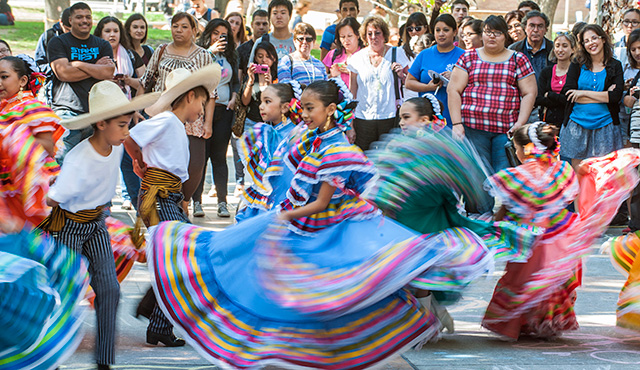The magic and mysticism of the ancestral customs and traditions of Hispanic Catholics has allowed the development of a vibrant religiosity and culture in the United States. The Roman Catholic Diocese of Orange organizes various annual events that directly and indirectly unite the various communities of Hispanics in Southern California: Mexicans, Salvadorans, Peruvians.
Mass for special children
This event has been a September tradition for almost a quarter of a century. The Mass for children and special people is celebrated by Bishop Tim Freyer on Sept. 12. It is for families whose children suffer from a physical, mental, or psychomotor disability.
“All these children are special in the heart of God because their parents have said yes to life,” said Bishop Kevin Vann. “Each of these lives are of great importance because they show us the presence of God.”
El Señor de los Milagros (the lord of miracles)
A Catholic devotional Mass of Peruvian ancestry, the festival is a procession with a replica of the Christ of Pachacamilla. The devotional began in Lima, Peru, in October 1687.
“Our Bishop Vann has warmly welcomed this devotional,” said Rosario Pacheco, spokesman for the Brotherhood of the Lord of Miracles, Pilgrim of Southern California. This year it will be celebrated on Oct. 21, at Christ Cathedral.
Día de los Muertos (Day of the Dead)
The celebration of the tradition of All Saints and All Souls or “Day of the Dead” is the result of the mixture of two cultures: Spanish and Indigenous people.
“Mesoamerican natives celebrated their ancestors throughout the month of August,” said Deacon Guillermo Torres, director of the Hispanic Ministries of the Diocese of Orange. “When the conquerors arrived, the cult of death merged with the Catholic religion.”
In Mexico and some Central American and South American countries, they celebrate their dead by going to the cemeteries to decorate them with flowers, and in their homes, they place altars, so that the beloved souls leave the beyond and wander a few days around the world, visiting their homes, families, and friends. People decorate their altars with food, candles, incense, liquor, flowers, photographs, music, and personal objects of the deceased.
Our Lady of Guadalupe
The Virgin of Guadalupe also plays an important religious role in Orange County. St. Junipero Serra who built the county’s first Catholic church in San Juan Capistrano brought with him the image of Our Lady of Guadalupe.
In 1976, when the Roman Catholic Diocese of Orange was established, Our Lady of Guadalupe was named the patroness of the diocese. Now she is revered by 1.3 million Catholics in O.C. every Dec. 12 with the traditional “Las Mañanitas” (“The Dawns”), a traditional birthday song in Mexico and other Latin American countries.
“The Virgin of Guadalupe for the Hispanic Catholic is the evangelizer of the Americas par excellence,” said Deacon Torres. “We understand her love as the direct communication of God’s divine love with her younger children and with the humble people. Our Lady of Guadalupe is the bridge that transforms two cultures: the oppressed and the oppressive, to grow in the love of God and open the door of faith.”
Las Posadas (The Inns)
Many parishes organize Las Posadas events; Christ Cathedral has celebrated the tradition for five years. More than 5,000 people have taken part.
The symbolism of the inns is a reminder of the expectation of the Child and the pilgrimage of Joseph and Mary of Nazareth to Bethlehem. Las Posadas are a means to prepare with joy and prayer our heart for the coming of Jesus Christ, and to remember and live the moments that Joseph and Mary passed before Jesus’ birth.
Other traditions
Day of the Three Wise Men
This event is celebrated on Jan. 6. Just as the Magi of the East, Melchior, Gaspar and Baltazar, took Jesus, gold, incense, and myrrh as gifts for His birth, the children of Mexican heritage place a shoe and inside it a letter. The letter requests gifts of the Magi on the Day of the Epiphany of the Lord, which is the first time that Jesus Christ is manifested to the world. At home, the “La Rosca de Reyes” a ring-shaped Mexican bread, decorated with slices of crystallized or candied fruit and served with hot chocolate. The person who finds the figure of the infant Jesus baked into the bread is selected to return to dress the Child Baby Jesus and to provide the tamales and atole (a hot drink made with corn and masa) for the dinner of Feb. 2, the Candelaria Day.
The Easter of the Resurrection
Deacon Guillermo Torres said that the Easter Triduum, the Passion, Death and Resurrection of Jesus, takes place in several parishes of the Diocese of Orange. Several young actors undertake to make this representation in a captivating way.
“It is impressive the impact on people by the revealing, historical and catechetical moments of the life of Jesus when they see the representation”, Torres said. “It is a symbol that represents our faith, culture and experience as Hispanic Catholics in Orange County.”

